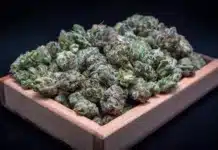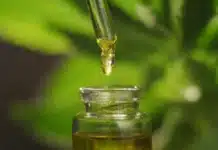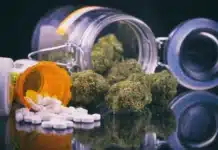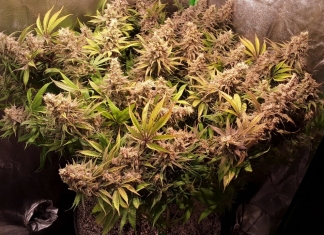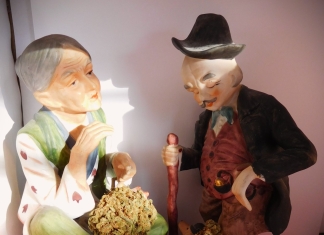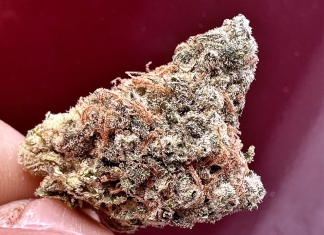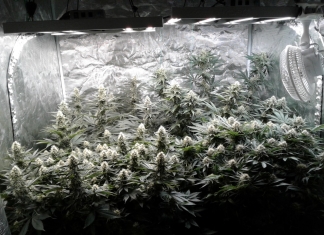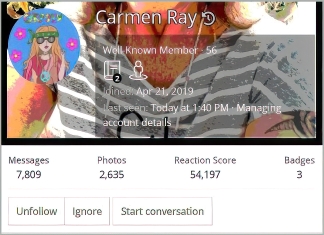Call it the New Marijuana Math: 91,000 Floridians are buying 56 pounds of pot a week under the orders of 1,400 doctors. A year and a half after an amendment to the state constitution legalized medical marijuana, the fledgling industry is finally starting to show some muscle.
“On the one hand, we should have been so much further along with this,” said Karen Goldstein, head of the Florida chapter of the National Organization for the Reform of Marijuana Laws (NORML). “The amendment was so clear — medical marijuana is legal — but the Legislature has muddied the water so much by creating regulations out of thin air.
“On the other hand, if you’re old enough to remember the 1960s, when people could get serious jail time just for having a single joint, it’s kind of amazing to see it handed to a customer across a store counter, and it’s all right out in the open and totally legal.”
When Floridians voted in 2016 to legalize medical use of the drug by an overwhelming 70 percent, gleeful marijuana activist and merchants around the country predicted half a million users would quickly sign up.
Slow movement by state regulators on everything from which companies could grow and sell marijuana to how patients could take it kept any weed gold rush in check. (Even the conservative Legislature fired off a letter to the Health Department last month accusing it of dragging its feet.) But by the end of May, the state Health Department’s Office of Medical Marijuana Use said it was registering new users at a clip of 5,400 a week, and the time required to process registrations is down to about two weeks.
“As the number of people with registration cards goes up, our business is going up with it,” said Eddie Ramos, who manages one of Miami-Dade County’s four medical marijuana stores, or dispensaries, as the image-conscious industry prefers to call them. “We’re serving 100 to 115 customers a day, seven days a week. Business is so good that Trulieve, the Tallahassee-based company that operates Ramos’ dispensary and 13 others around the state, held a job fair last week trying to fill 100 positions.
An even more potent sign of the industry’s health: In January, the New York firm iAnthus Capital Holdings bought the Lake Wales-based medical marijuana company GrowHealthy for $47.5 million even though GrowHealthy hadn’t yet sold a single penny’s worth of marijuana. (GrowHealthy still hasn’t opened a dispensary, though it’s now making deliveries across the state.)
Many industry analysts believe it will take another giant step forward if appellate courts uphold a Leon County judge’s ruling last month that the state’s ban on smoking medical marijuana is unconstitutional. The Legislature, in writing the law implementing the constitutional amendment legalizing medical pot, said the only forms of it that could be used were oils (which can be vaped as well as eaten or applied topically), tinctures, sprays and edibles.
“The ban on smoking is really stupid,” said Jonathan Leguizamon, a 28-year-old U.S. Army veteran who lives in Miami Lakes and is a regular user of medical marijuana. “For most people, smoking is the most familiar form of it. They’re uneasy with a spray or a pill.”
Leguizamon uses marijuana to help him cope with post-traumatic stress disorder that developed after an incident while he was stationed at a military camp near Basra, Iraq. No stranger to being shot at — Iraqi insurgents regularly shelled his camp, “sometimes as many as 50 times a day on American holidays, which they all had memorized,” he recalls — Leguizamo finally lost it on an otherwise peaceful afternoon, so quiet he went outside the walls for lunch.
“The mortar rounds were coming in all around , and I saw one that looked like it was headed right or me,” he said. “I thought, ‘Oh my God, this is it, I’m dead,’ and I hit the ground, which is about all I could do.” The shell actually hit a little bit further up the grounds — but it inflicted unspeakably terrible wounds on another American soldier and a civilian bystander.
“I ran over, I tried to help them, even though I could see it was useless, but you just have to try, you can’t do nothing,” he said. “Then some buildings caught fire, it was so hot, and I had to get away.”
It had been a terrible thing to go through, but in reality not so much more terrible than some other days in the war, and Leguizamon thought he had mostly moved past it. But several months later, not long before his scheduled departure from Iraq, he started having flashbacks whenever he heard a bell. Then the grisly nightmares began.
By the time he reached his unit’s new assignment in Colorado, army doctors were treating Leguizamon for PTSD with all sorts of exotic drugs, none of which was helping. Finally a friend suggested: “Look, we’re in Colorado, medical marijuana’s legal here. Why don’t you get a card and try it? They say it can help with PTSD.”
Leguizamon, who had been a jock in high school, had no experience with pot. “My wrestling and football coaches always said it would mess us up, make us weak, and I believed them,” he said. But nothing could be as bad as the flashbacks and nightmares, he reasoned, and gave it a try. The relief was quick.
“I got a euphoric high,” he said. “But it wasn’t just that. I felt happy, I felt motivated to do things, I lost my paranoia. I could get out of my house again. I could take my daughter to the park. I didn’t have to watch my back.”
Leguizamon, though, did feel trapped in Colorado. He and his wife wanted to return to South Florida, where they grew up, but there was no medical marijuana. He delightedly came back when the constitutional amendment passed — but the restrictions on smoking and the unavailability of the particular strain of marijuana he used in Colorado (Florida law permits growing only three of the nearly 800 known strains of the plant) disillusioned him.
Soon he began supplementing his legal medical marijuana with illegal weed purchased on the street.
It’s weird and unsettling for Leguizamon, who had no experience at the ins and outs of the dope business. “It was really pretty scary at first,” he said. “It made me a bit paranoid again — night-time meetings, thinking it through tactically, how and where to park, being careful not to tell the seller what my vehicle looked like so I could get a look at him first. It was like being back in Iraq, but it wasn’t a flashback…. Florida needs to relax these rules and get some more variety and flexibility into its program.”
The ban on smoking is just one of many speed bumps the Legislature or the Health Department placed in the path of medical marijuana:
• Not only were users prohibited from growing pot for personal consumption, practically any company that wasn’t an agribusiness giant was excluded by a requirement for a non-refundable $60,000 application fee.
• Eighteen months later, only five companies have been authorized to open dispensaries, and there are only 37 dispensaries to serve the entire state, mostly clustered in large cities along coastal areas. Many of the dispensaries do deliver over long distances — the Trulieve dispensary near Miami International will carry the drug as far as Key West — but the drug can be accepted only by the patient, not a friend or family member.
• Finding a doctor to approve a patient for medical marijuana — which the state requires — can be extraordinarily difficult, especially outside big metropolitan areas. Only a doctor who has completed a state course on marijuana can approve a patient. The course originally took eight hours to complete and cost about $1,000, and almost none of Florida’s 46,000 licensed physicians signed up. Even when the state slashed it to two hours and $250, the response has been minimal.
The time and expense for the course is unattractive to doctors, who don’t see medical marijuana as a major part of their practice, said Miami osteopath Michelle Weiner, but there are other factors that discourage them as well — mainly, not knowing anything about the medical uses of marijuana.
“Even that course the state makes you take about the legal aspects of medical marijuana,” she said. “And this is not something you learn about in medical school, because until recently it was illegal, so what was the point? You’ll find very few physicians who know what can be treated with marijuana or the proper dosages, which is a shame because it’s got a lot of potential medical uses.”
Weiner herself took the course and has about 750 patients who use the drug. A pain-management specialist, Weiner became interested in marijuana when she realized its potential as an alternative to opiods, which are great at reducing pain but also addictive and often lethal.
“This was a no-brainer for me,” she said. “And it’s the perfect time for medical marijuana to become available as a painkiller, because the government is putting some pretty harsh restrictions on opiods. If people with chronic pain can’t get a Percocet, they’re going to turn to the street, where maybe they’ll get involved with a drug like heroin. What would you rather have, somebody using heroin or somebody using marijuana?”
The maze of regulations, coupled with the inevitable uncertainties of a new industry revolving around a substance that until recently was wholly illegal, has made the medical marijuana landscape a bit rocky. “At times, it’s a bit like the frontier, people confused about where they are or what they can do,” said NORML’s Goldstein.
“I have people calling me saying, ‘I was hoping to open a medical marijuana business there, should I move?’ or ‘I need marijuana to treat my convulsions, will I be able to get it if I’m visiting Florida?’ We’re getting there, though.”
Certainly the Trulieve dispensary tucked away among the warehouses and rental car lots across from the Miami airport seems to be operating like a normal and reasonably efficient business, not a Cheech-and-Chong madhouse.
“That’s the biggest misconception people have when they come in for the first time,” said Ramos, the manager. “They think it’s going to be like a vape shop. And instead everybody’s wearing a uniform and talking like a professional.” His customers run anywhere from 18 to 50 years in age, he said, though during the Herald’s midday visit, a surprising number seemed middle-age and above.
Customers can enter the shop only by being buzzed in through a security door, and that only gets them into a small lobby with a receptionist and an armed security guard. (A state requirement, but not one the Trulieve staff objects to; they are, after all, sitting on a pricey stash of drugs.) Only with the state medical marijuana patient card can they get into the back room where the merchandise is stored.
They’re admitted there three or four at a time. Inside they find two medium-sized glass counters, not unlike the ones you might see in a cell-phone store, overseen by several Trulieve staffers called “consultants” who look at their doctors’ referrals. That will include an approval for supplies of 30, 45 or 70 days, along with any restrictions — for instance, only topical ointments to be rubbed on the skin — the doctor has laid down.
But often the customers have a fair amount of leeway in choosing the strain of their marijuana and the way it’s taken. (Vaping? A drop of tincture under the tongue?) The consultants, some of them medical marijuana users themselves, are well-versed not only on the strains of pot but on all the hardware that can be used to deliver them. They happily demonstrate vaporizers and the little cups of ground marijuana bud or cartridges of oil extract that are used with them.
By the way, “bud” — the part of the marijuana plant that makes you high — is known in the industry as “flower.” Five decades of hippie marijuana jargon has largely been jettisoned by a business anxious to separate itself from stoner image. Words like “lid” or “quarter” that were used to specify quantities are never heard inside Trulieve; even the ubiquitous “joint” and “blunt” have disappeared, although that may have more to do with Florida’s ban on smoking the weed as with image remaking.
One thing that hasn’t changed: the high. Almost everything sold at dispensaries contains THC (though at much lesser potency than the stuff you buy in baggies out on the street), the ingredient that gives marijuana its buzz. “Marijuana is marijuana, no matter what you’re using it for,” said one patient. “You can definitely get a little high with most of this stuff.”
Most of the products at Trulieve run between $35 and $115, though some of the hardware, like a tabletop vaporizer, can go as (pardon the expression) high as $750. “I think the average purchase is somewhere between $100 and $150,” said Ramos. A lot of first-time customers are dismayed to learn they can’t use credit cards — marijuana is still illegal under federal law, and banks don’t want to be involved — though the store has an ATM.
What it doesn’t have: insurance forms or receipts. No insurance company covers medical marijuana.



